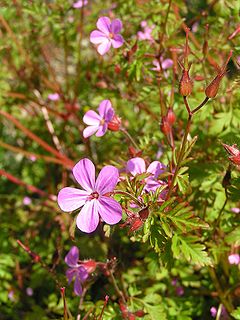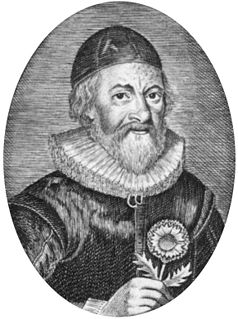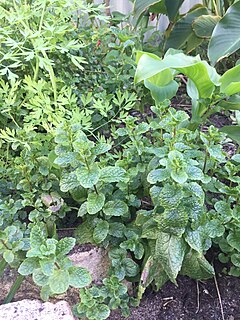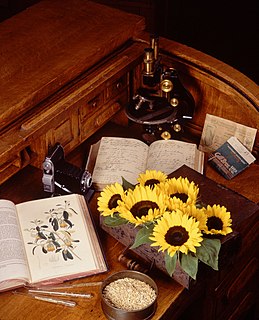Related Research Articles

Lemon balm, balm, common balm, or balm mint, is a perennial herbaceous plant in the mint family Lamiaceae and native to south-central Europe, the Mediterranean Basin, Iran, and Central Asia, but now naturalized in the Americas and elsewhere.

Herbal medicine is the study of pharmacognosy and the use of medicinal plants. Plants have been the basis for medical treatments through most of human history, and such traditional medicine is still widely practiced today. Modern medicine makes use of many plant-derived compounds as the basis for evidence-based pharmaceutical drugs. Although herbalism may apply modern standards of effectiveness testing to herbs and medicines derived from natural sources, few high-quality clinical trials and standards for purity or dosage exist. The scope of herbal medicine is sometimes extended to include fungal and bee products, as well as minerals, shells and certain animal parts.

Traditional medicine comprises medical aspects of traditional knowledge that developed over generations within various societies before the era of modern medicine. The World Health Organization (WHO) defines traditional medicine as "the sum total of the knowledge, skills, and practices based on the theories, beliefs, and experiences indigenous to different cultures, whether explicable or not, used in the maintenance of health as well as in the prevention, diagnosis, improvement or treatment of physical and mental illness". Traditional medicine is contrasted with scientific medicine.

John Gerard was an English botanist with a large herbal garden in London. He was the author of a 1,484-page illustrated Herball, or Generall Historie of Plantes, first published in 1597. It became the most prevalent botany book in English in the 17th century. Except for additions of some plants from his own garden and from North America, Gerard's Herbal is largely an unacknowledged English translation of Rembert Dodoens's herbal, published in 1554, itself highly popular in Dutch, Latin, French and other English translations. Gerard's Herball contains profuse, high-quality drawings of plants, with the printer's woodcuts largely derived from Continental European sources, but there is an original title page with a copperplate engraving by William Rogers. Two decades after Gerard's death, the book was corrected and expanded to about 1700 pages. The botanical genera Gerardia were named in Gerard's honour.

Nicholas Culpeper was an English botanist, herbalist, physician and astrologer. His The English Physitian is a store of pharmaceutical and herbal knowledge, and Astrological Judgement of Diseases from the Decumbiture of the Sick (1655) one of the most detailed works on medical astrology in Early Modern Europe. Culpeper catalogued hundreds of outdoor medicinal herbs. He scolded some methods of contemporaries: "This not being pleasing, and less profitable to me, I consulted with my two brothers, Dr. Reason and Dr. Experience, and took a voyage to visit my mother Nature, by whose advice, together with the help of Dr. Diligence, I at last obtained my desire; and, being warned by Mr. Honesty, a stranger in our days, to publish it to the world, I have done it." Culpeper came from a line of notabilities, including Thomas Culpeper, lover of Queen Catherine Howard, also a distant relative, sentenced to death by her husband, Henry VIII.

A herbal is a book containing the names and descriptions of plants, usually with information on their medicinal, tonic, culinary, toxic, hallucinatory, aromatic, or magical powers, and the legends associated with them. A herbal may also classify the plants it describes, may give recipes for herbal extracts, tinctures, or potions, and sometimes include mineral and animal medicaments in addition to those obtained from plants. Herbals were often illustrated to assist plant identification.

Geranium robertianum, commonly known as herb-Robert, red robin, death come quickly, storksbill, fox geranium, stinking Bob, squinter-pip (Shropshire), crow's foot, or Roberts geranium, is a common species of cranesbill native to Europe and parts of Asia, North America, and North Africa.

Medicinal plants, also called medicinal herbs, have been discovered and used in traditional medicine practices since prehistoric times. Plants synthesise hundreds of chemical compounds for functions including defence against insects, fungi, diseases, and herbivorous mammals. Numerous phytochemicals with potential or established biological activity have been identified. However, since a single plant contains widely diverse phytochemicals, the effects of using a whole plant as medicine are uncertain. Further, the phytochemical content and pharmacological actions, if any, of many plants having medicinal potential remain unassessed by rigorous scientific research to define efficacy and safety.

Chelidonium majus, commonly known as greater celandine, is a perennial herbaceous plant in the poppy family (Papaveraceae). It is one of two species in the genus Chelidonium. It is native to Europe and western Asia and introduced widely in North America.

Dioscorea villosa is a species of twining tuberous vine which is native to eastern North America. It is commonly known as wild yam, colic root, rheumatism root, devil's bones, and fourleaf yam. It is common and widespread in a range stretching from Texas and Florida north to Minnesota, Ontario and Massachusetts. It is currently on the United Plant Savers "At Risk" list. UpS is an organization concerned with the preservation of endangered medicinal plants on the territory of North America.

John Parkinson was the last of the great English herbalists and one of the first of the great English botanists. He was apothecary to James I and a founding member of the Worshipful Society of Apothecaries in December 1617, and was later Royal Botanist to Charles I. He is known for two monumental works, Paradisi in Sole Paradisus Terrestris, which generally describes the proper cultivation of plants; and Theatrum Botanicum, the most complete and beautifully presented English treatise on plants of its time. One of the most eminent gardeners of his day, he kept a botanical garden at Long Acre in Covent Garden, today close to Trafalgar Square, and maintained close relations with other important English and Continental botanists, herbalists and plantsmen.
James A. Duke was an American botanist. He was the author of numerous publications on botanical medicine, including the CRC Handbook of Medicinal Herbs. He was well known for his 1997 bestseller, The Green Pharmacy. He developed the Dr. Duke's Phytochemical and Ethnobotanical Databases at the USDA.
Ellen Evert Hopman is an author of both fiction and non-fiction, an herbalist, a lay homeopath, a lecturer, and a Mental Health Counselor who lives and works in Western Massachusetts. She is the author of several books and audio tapes on Paganism and Druidry, and three novels. She is a certified writing teacher with Amherst Writers and Artists and a multiple recipient of the Golden Oak Award. She was formerly a Professor of Wortcunning at the Grey School of Wizardry, where she taught herbalism, Celtic Neopaganism, Celtic history and Celtic lore. She is a professional member of the American Herbalists Guild and a member of the Grey Council of Mages and Sages. She has taught Druidry and herbalism in the United States, Scotland, Ireland and Canada, and has been a speaker and workshop leader at numerous Neopagan and New Age events, and a subject of articles in The New York Times.
Arthur Lee "Tommie" Bass was an Appalachian herbalist who lived near Lookout Mountain, Alabama.
Rosemary Gladstar is an American herbalist.
The Indiana Botanic Gardens is the largest and oldest retailer of herbs in the United States.

A physic garden is a type of herb garden with medicinal plants. Botanical gardens developed from them.

In general use, herbs are plants with savory or aromatic properties that are used for flavoring and garnishing food, for medicinal purposes, or for fragrances; excluding vegetables and other plants consumed for macronutrients. Culinary use typically distinguishes herbs from spices. Herbs generally refers to the leafy green or flowering parts of a plant, while spices are usually dried and produced from other parts of the plant, including seeds, bark, roots and fruits.

The history of botany examines the human effort to understand life on Earth by tracing the historical development of the discipline of botany—that part of natural science dealing with organisms traditionally treated as plants.
The history of herbalism is closely tied with the history of medicine from prehistoric times up until the development of the germ theory of disease in the 19th century. Modern medicine from the 19th century to today has been based on evidence gathered using the scientific method. Evidence-based use of pharmaceutical drugs, often derived from medicinal plants, has largely replaced herbal treatments in modern health care. However, many people continue to employ various forms of traditional or alternative medicine. These systems often have a significant herbal component. The history of herbalism also overlaps with food history, as many of the herbs and spices historically used by humans to season food yield useful medicinal compounds, and use of spices with antimicrobial activity in cooking is part of an ancient response to the threat of food-borne pathogens.
References
- ↑ David J Owen (2002). The Herbal Internet Companion: Herbs and Herbal Medicine Online. Psychology Press. pp. 32–33. Retrieved January 21, 2014.
- ↑ Ram J. Singh (2011). Genetic Resources, Chromosome Engineering, and Crop Improvement. CRC Press. p. 40. Retrieved January 21, 2014.
- ↑ Susan G. Wynn (2007). Veterinary Herbal Medicine. Elsevier Health Sciences. p. 246. Retrieved January 21, 2014.
- ↑ Nancy Phillips (2005). The Herbalist's Way: The Art and Practice of Healing with Plant Medicines. Chelsea Green Publishing. pp. 307–310. Retrieved January 21, 2014.
- ↑ Shatoiya De la Tour (2001). The Herbalist's Garden: A Guided Tour of 10 Exceptional Herb Gardens. Storey Books. pp. 42, 51. Retrieved January 21, 2014.
- ↑ Gabriell DeBear Paye (2000). Cultural Uses of Plants: A Guide to Learning About Ethnobotany. New York Botanical Garden Press. p. 143. Retrieved January 21, 2014.